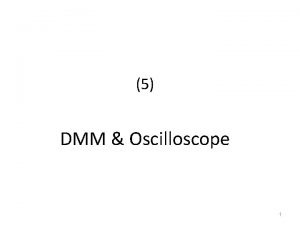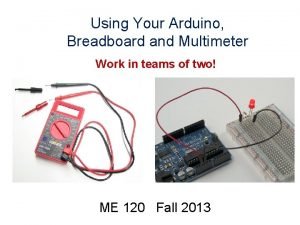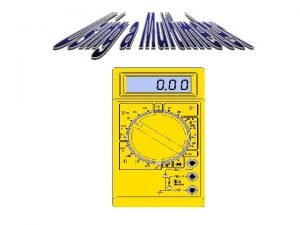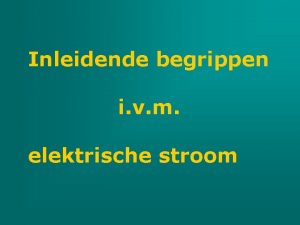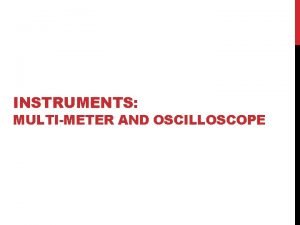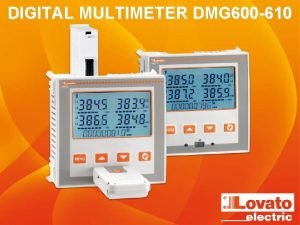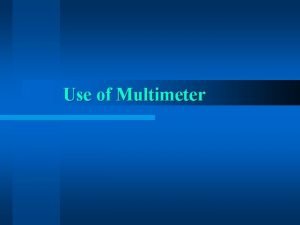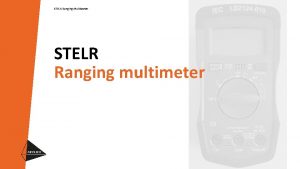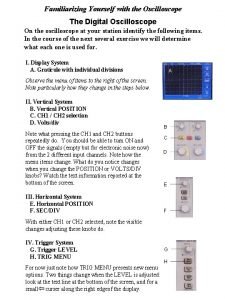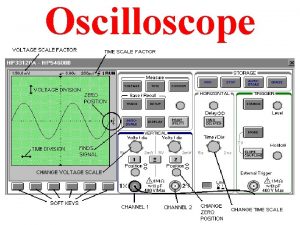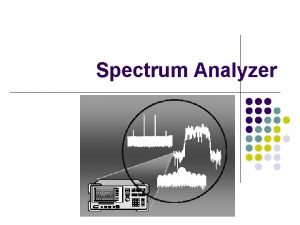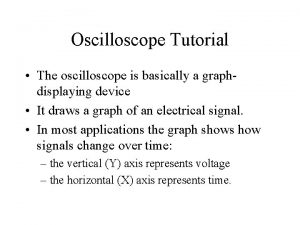5 DMM Oscilloscope 1 Digital Multimeter DMM DMM



























- Slides: 27

(5) DMM & Oscilloscope 1

Digital Multi-meter (DMM) DMM can be used to measure: • • DC voltage AC voltage current resistance BJT (β test) diode test short circuit test, etc. 2

Digital Multi-meter (DMM) • Basically, DMM can only measure DC voltage. Current, resistance, or AC voltage are converted into DC voltage. • A main component of DMM is the Analog-to-Digital converter (ADC) which converts the measured analog DC voltage into a digital quantity to be displayed on the LCD. 3

Digital Multi-meter (DMM) • The range determines the maximum voltage to be measured. In the same time, it changes the position of the decimal point on LCD. This determines how refined or precise is the reading. This is called the resolution. • DMMs have high input impedance (~10 MΩ), which will not load down sensitive circuits. • Next are some notes about measurements using DMM. 4

AC Voltage Measurement • Let us first remember what is meant by average and RMS values of an AC signal. • For pure sine wave: 5

AC Voltage Measurement • The RMS value of an AC signal is the equivalent DC voltage that dissipates the same heat (energy) as the AC signal. • In AC volt measurement, most DMMs, in reality, measure the average but displays the RMS value using the correction: • Therefore, measuring complex waveforms (other than pure sine) gives wrong RMS value. A True RMS meter is needed in this case! 6

Current measurements To measure current: • Turn the power to the circuit off • Open the circuit • Connect the meter in series with the circuit • Re-establish power. Care must be taken because the meter is now a part of the circuit. 7

Current measurements • Although most DMMs have a maximum current capability of 10 A, in practice, only small currents are measured with a DMM, such as 4 -20 m. A found in most process control systems. • One common mistake is to measure voltage with the test leads in the current input jacks (their input impedance is 0. 1~8Ω, i. e. a short circuit). Most DMM current input jacks are fused for protection. You will blow the fuse if you test in this manner. 8

Clamp-on meters A safe method for measuring currents (of at least 1 A) is the clamp meter which avoids the requirement of breaking the circuit being measured. The meter clamps onto a currentcarrying conductor, and the output reading is obtained by transformer action. 9

Clamp-on meters The clamp-on jaws of the instrument act as a transformer core and the current-carrying conductor acts as a primary winding. Current induced in the secondary winding is rectified and applied to a meter. 10

Resistance measurements To measure resistance: 1. Turn power to circuit OFF to obtain accurate resistance readings and to protect the meter. 2. Disconnect one lead of the resistor from the circuit to eliminate the effect of components in parallel with the resistor being measured. 3. Place the meter in the (Ω) function. The meter will display “OL” indicating an infinite reading. 4. Place the test leads on each side of the resistor and choose a suitable range with the dial. 11

Continuity measurement • Continuity is a great test circuit connections, switches and fuses. • The meter gives an audible alarm signal if the two points in the circuit are connected. • Most meters will indicate continuity from 0 to 50Ω. 12

Diode test • To test a diode with a DMM, the diode function applies an appropriate voltage and then measures the voltage drop across the diode. • In the forward direction, the voltage drop should be around 0. 5± 0. 2 V while in the reverse direction, you should see an “OL” on the display. 13

The Oscilloscope • The scope is used to displays a time varying voltage waveform. The vertical (Y) axis represents voltage and the horizontal (X) axis represents time. • From the graph many information about the signal can be obtained such as: shape, amplitude, period, frequency, phase, DC and AC components, noise, etc. 14

Digital storage oscilloscope (DSO) DSO acquires the waveform as a series of samples, converts them into digital words, and stores them in memory. The stored values can be displayed on the screen, using interpolation to smooth the waveform shape between data points. 15

DSO capabilities • Capture and view transient events that may happen only once. • Offer many math operations done on displayed waveforms such as addition, multiplication, integration, Fast Fourier Transform. • Measurement cursors to take accurate readings. • Interface to the computer. 16

Oscilloscope front panel • The front panel includes a display screen, knobs, and buttons used to control signal acquisition and display. • The front panel also includes input connectors for the probes. • Oscilloscopes have high input impedance, typically 1 MΩ. Therefore, they have negligible loading effect in most measurement situations. 17

Oscilloscope front panel • The grid markings on oscilloscope screen consists of 8 -by 10 major divisions. • There also tick marks called minor divisions. 18

Oscilloscope front panel • To measure a waveform you need to adjust (volt/division) and the “sweep rate” (time/division). • To get accurate measurements, make the waveform occupies most of the display vertically and at least two cycles horizontally. 19

Trigger System • Imagine the jumble on the screen that would result if each sweep started at a different place on the signal. • Trigger stabilizes the waveform by controlling where, on a waveform’s voltage and slope, the display trace or sweep begins each time. • By this way, periodic signals such as sine waves appear static on the oscilloscope display. 20

Trigger Level and Slope • Oscilloscope pauses each time the sweep reaches the extreme right side of the screen. The scope then waits until the input waveform reaching a user-specified threshold voltage before drawing the next trace. • The trigger point is determined by the level (voltage) and slope (+ve or –ve edge). 21

Trigger Modes: Auto vs. Normal • In Auto mode the oscilloscope sweeps, even without a trigger. This ensures that the display will not be frozen if the signal does not cause a trigger. • In normal mode the oscilloscope only sweeps if the input signal reaches the trigger point; otherwise the display will be frozen on the last acquired waveform. • In practice, you will probably start with auto mode because it requires less adjustment and then use normal mode because it lets you see just the signal of interest. 22

Input Coupling (DC – AC – GND) • DC coupling shows the whole signal (AC+DC components). • AC coupling blocks the DC component of a signal (you see the waveform centered around 0 V). This is useful when the entire signal (AC+DC) is too large for the volts/div setting. • Ground coupling (GND) disconnects the input signal from the vertical system, which lets you see a horizontal line on the screen that represents 0 V. 23

Pulse Measurements In many applications, the shape of pulses is important. Pulses can become distorted and cause a digital circuit to malfunction. Standard pulse measurements are pulse width and pulse rise time. 24

Pulse Measurements Rise time is the time a pulse takes to go from low to high voltage. By convention, the rise time is measured from 10% to 90% of the full voltage of the pulse. This eliminates any irregularities at the pulse’s transition corners. Pulse width is the time the pulse takes to go from low to high and back to low again. By convention, the pulse width is measured at 50% of full voltage. 25

Oscilloscope Bandwidth • Most important specifications of an oscilloscope are the bandwidth and rise time. • Bandwidth is the maximum frequency over which the oscilloscope amplifier gain is within -3 d. B of its peak value (~ 70. 7% of maximum value). • When applied to signalamplitude measurement, the oscilloscope is only usable at frequencies up to about 0. 3 times its specified bandwidth. 26

The rise time • Oscilloscopes are normally designed such that: Bandwidth x Rise time = 0. 35 • Thus, for a bandwidth of 100 MHz, Rise time = 0. 35/108 = 3. 5 ns. • Therefore, this oscilloscope is able to display pulses with rise time no less than 3. 5 ns. Faster pulses can not be well displayed with this oscilloscope. 27
 Difference between dmm and oscilloscope
Difference between dmm and oscilloscope Kelebihan multimeter digital adalah
Kelebihan multimeter digital adalah Signal generator proteus
Signal generator proteus Satuan dalam si multimeter
Satuan dalam si multimeter Multiméter részei
Multiméter részei Breadboard multimeter
Breadboard multimeter Multi tester function
Multi tester function Multimeter manual vs auto ranging
Multimeter manual vs auto ranging What is this?
What is this? Digitalni multimeter merkur
Digitalni multimeter merkur Microfarad symbol on multimeter
Microfarad symbol on multimeter Multimeter dan bagiannya
Multimeter dan bagiannya Multimeter introduction
Multimeter introduction Werkelijke stroomzin
Werkelijke stroomzin Loopback adapter tool
Loopback adapter tool Hierarchists
Hierarchists Dmm lab
Dmm lab Dmm psychology
Dmm psychology Crittenden dmm
Crittenden dmm Cmmi dmm
Cmmi dmm Izu subs
Izu subs Dmm lab
Dmm lab Oscilloscope fundamentals
Oscilloscope fundamentals Electrical engineering
Electrical engineering In an oscilloscope tube what is the purpose of the heater
In an oscilloscope tube what is the purpose of the heater An oscilloscope display grid or scale is called a
An oscilloscope display grid or scale is called a Oscilloscope high pitch
Oscilloscope high pitch Agilent oscilloscope basics
Agilent oscilloscope basics
